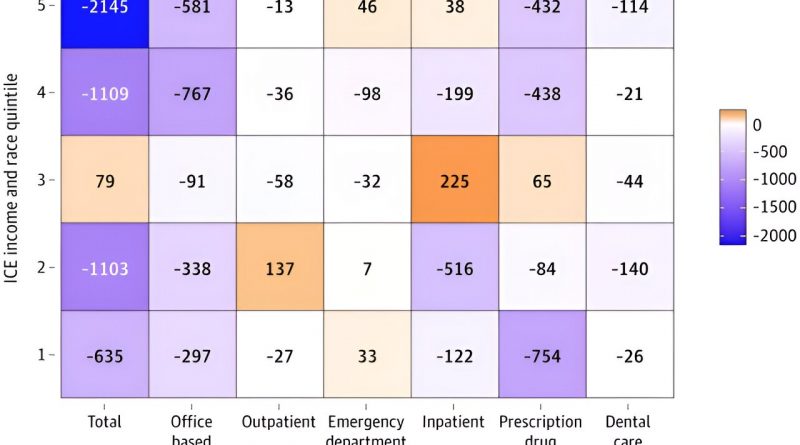Black and white adults have similar health care expenditure levels in racially and economically integrated communities

Differences in health care expenditures between Black and white adults vary substantially with the local level of racial and economic integration, and tend to be low or nonexistent in highly integrated communities, according to a study led by researchers at the Johns Hopkins Bloomberg School of Public Health.
For their study, the researchers compared health care expenditures for a nationally representative sample of Black and white adults in census tracts across the United States. They found that, at the same level of health, health expenditures by Black adults were much lower than white adults’ in census tracts with the lowest levels of racial integration but were virtually the same in tracts where the level of integration was highest.
The researchers also found that more-integrated areas also had signs of more equitable health access for Black and white adults.
Individuals’ health expenditures are indicators of people’s health needs and the types of health care they may or may not be able to access. The findings add to evidence that health disparities between Black and white adults are largely attributable to social factors that can be changed.
The study was published online November 3 in JAMA Health Forum.
“Fixing health care disparities may require both health care and non-health care solutions—making sure people have health insurance and that the resources they have based on where they live give them the best opportunities to be healthy,” says study lead author Lorraine Dean, ScD, an associate professor in the Bloomberg School’s Department of Epidemiology.
“We already knew from previous research that health disparities mostly disappeared when Black and white adults lived in more equitable areas—now we know that extends to health care expenditures, too.”
Because of external factors—including different levels of exposure to poverty, economic opportunity, health care access, and neighborhood environments—life expectancy, disease risk, health outcomes, and other health care-related measures have long been known to differ between white and Black Americans. Black adults on average have shorter lives and higher rates of common ailments including diabetes, hypertension, and kidney disease.
A 2011 study, also by Bloomberg School researchers including a co-author of the new study, Darrell Gaskin, Ph.D., the William C. and Nancy F. Richardson Professor in the Bloomberg School’s Department of Health Policy and Management, described a racially and socioeconomically integrated area of Baltimore in which disparities in the rates of hypertension, diabetes, and other health measures were much lower than national averages, and for some measures disappeared entirely.
The study used the term “place, not race” to capture the findings.
In the new study, Dean and colleagues addressed the closely related issue of whether health care expenditures vary with the level of racial and socioeconomic integration.
For their analysis, the researchers used data from a 2016 U.S. government survey called the Medical Expenditure Panel Survey (MEPS), which included data on race, socioeconomic status, health status, health care access, health care use, and health care expenditures (including insurer payments) for a nationally representative sample of Americans.
The investigators also used data on each MEPS participant’s community levels of racial and socioeconomic integration, based on the U.S. Census Bureau’s American Community Survey (ACS) for 2013–17.
The analysis covered a total of 7,062 adult MEPS participants age 21 or older—one-third of them Black, two-thirds white—living in 2,238 census tracts where the population was at least five percent Black.
For each of these census tracts, the researchers used census data to calculate a measure of socioeconomic and Black/white integration called the Index of Concentration at the Extremes (ICE). They defined this as the number of non-Hispanic white adults in high-income (≥$100,000) households minus the number of non-Hispanic Black persons in low-income (<$20,000) households, divided by the total population with known income in that census tract.
The analysis, which adjusted for potential confounding factors such as age, sex, and education level, found that in communities where the ICE was highest—many high-income white adults, few low-income Black adults—racial disparities in health care expenditures were pronounced.
In these relatively non-integrated communities, Black adults spent $2,145 less on health care per year compared to white adults. These differences could reflect undertreatment for Black adults or overuse of health care by white adults. By contrast, in communities where the ICE was in a medium range, indicating the highest level of racial and socioeconomic integration, these expenditure disparities mostly disappeared—the computed difference in overall annual expenditure being a mere $79.
In the least integrated communities, where Black adults had lower overall health care expenditures, they still had levels of physical health similar to white adults’. Their lower overall expenditures were driven mainly by lower doctor’s-office, prescription drug, and dental expenditures. But in highly integrated areas, differences in individual expenditure categories were minimized. The most integrated areas also had relatively equitable health care access, according to MEPS data.
On the whole, the researchers say, the findings suggest that reducing health care expenditure disparities between Blacks and whites is possible, though it might be much easier to achieve in areas where socioeconomic and health care access disparities are minimized.
More information:
Lorraine T. Dean et al, Health Care Expenditures for Black and White US Adults Living Under Similar Conditions, JAMA Health Forum (2023). DOI: 10.1001/jamahealthforum.2023.3798.
Journal information:
JAMA Health Forum
Source: Read Full Article
